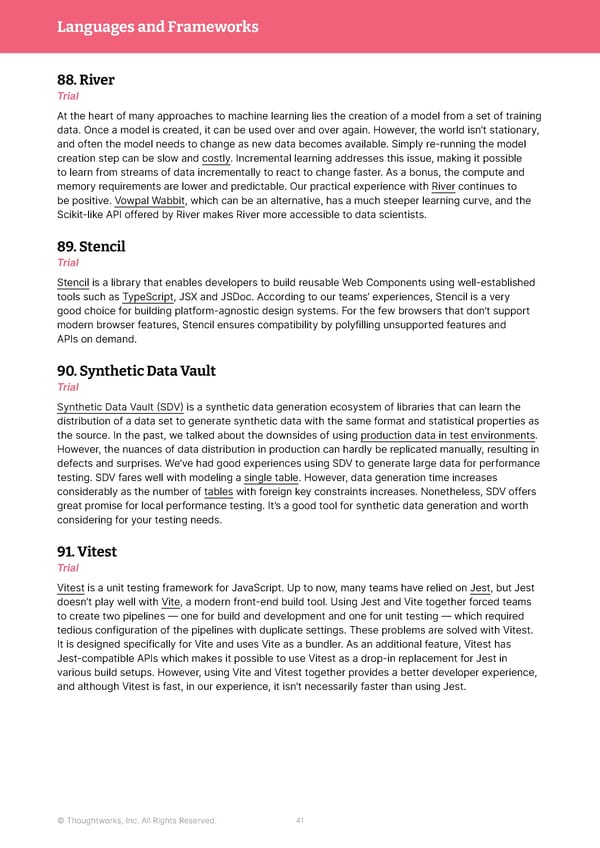Languages and Frameworks 88. River Trial At the heart of many approaches to machine learning lies the creation of a model from a set of training data. Once a model is created, it can be used over and over again. However, the world isn’t stationary, and often the model needs to change as new data becomes available. Simply re-running the model creation step can be slow and costly. Incremental learning addresses this issue, making it possible to learn from streams of data incrementally to react to change faster. As a bonus, the compute and memory requirements are lower and predictable. Our practical experience with River continues to be positive. Vowpal Wabbit, which can be an alternative, has a much steeper learning curve, and the Scikit-like API offered by River makes River more accessible to data scientists. 89. Stencil Trial Stencil is a library that enables developers to build reusable Web Components using well-established tools such as TypeScript, JSX and JSDoc. According to our teams’ experiences, Stencil is a very good choice for building platform-agnostic design systems. For the few browsers that don’t support modern browser features, Stencil ensures compatibility by polyfilling unsupported features and APIs on demand. 90. Synthetic Data Vault Trial Synthetic Data Vault (SDV) is a synthetic data generation ecosystem of libraries that can learn the distribution of a data set to generate synthetic data with the same format and statistical properties as the source. In the past, we talked about the downsides of using production data in test environments. However, the nuances of data distribution in production can hardly be replicated manually, resulting in defects and surprises. We’ve had good experiences using SDV to generate large data for performance testing. SDV fares well with modeling a single table. However, data generation time increases considerably as the number of tables with foreign key constraints increases. Nonetheless, SDV offers great promise for local performance testing. It’s a good tool for synthetic data generation and worth considering for your testing needs. 91. Vitest Trial Vitest is a unit testing framework for JavaScript. Up to now, many teams have relied on Jest, but Jest doesn’t play well with Vite, a modern front-end build tool. Using Jest and Vite together forced teams to create two pipelines — one for build and development and one for unit testing — which required tedious configuration of the pipelines with duplicate settings. These problems are solved with Vitest. It is designed specifically for Vite and uses Vite as a bundler. As an additional feature, Vitest has Jest-compatible APIs which makes it possible to use Vitest as a drop-in replacement for Jest in various build setups. However, using Vite and Vitest together provides a better developer experience, and although Vitest is fast, in our experience, it isn’t necessarily faster than using Jest. © Thoughtworks, Inc. All Rights Reserved. 41
 Immersive Experience — Vol 28 | Thoughtworks Technology Radar Page 40 Page 42
Immersive Experience — Vol 28 | Thoughtworks Technology Radar Page 40 Page 42